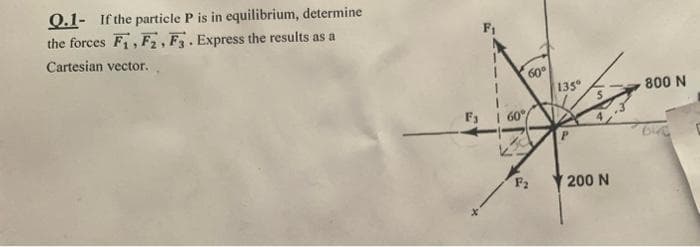Q.1- If the particle P is in equilibrium, determine the forces F₁, F₂, F3. Express the results as a Cartesian vector. F₁ 60° F2 135 P 200 N 800 N Бис
Q.1- If the particle P is in equilibrium, determine the forces F₁, F₂, F3. Express the results as a Cartesian vector. F₁ 60° F2 135 P 200 N 800 N Бис
Principles of Physics: A Calculus-Based Text
5th Edition
ISBN:9781133104261
Author:Raymond A. Serway, John W. Jewett
Publisher:Raymond A. Serway, John W. Jewett
Chapter1: Introduction And Vectors
Section: Chapter Questions
Problem 4OQ: What is the y component of the vector (3i8k) m/s? (a) 3 m/s (b) 8 m/s (c) 0 (d) 8 m/s (e) none of...
Related questions
Question
Fast pls in 5 min i will give u like for sure

Transcribed Image Text:Q.1- If the particle P is in equilibrium, determine
the forces F₁, F₂, F3. Express the results as a
Cartesian vector.
F3
60°
F2
135
P
200 N
800 N
Bi
Expert Solution
This question has been solved!
Explore an expertly crafted, step-by-step solution for a thorough understanding of key concepts.
This is a popular solution!
Trending now
This is a popular solution!
Step by step
Solved in 2 steps with 3 images

Knowledge Booster
Learn more about
Need a deep-dive on the concept behind this application? Look no further. Learn more about this topic, physics and related others by exploring similar questions and additional content below.Recommended textbooks for you

Principles of Physics: A Calculus-Based Text
Physics
ISBN:
9781133104261
Author:
Raymond A. Serway, John W. Jewett
Publisher:
Cengage Learning

University Physics Volume 1
Physics
ISBN:
9781938168277
Author:
William Moebs, Samuel J. Ling, Jeff Sanny
Publisher:
OpenStax - Rice University

Principles of Physics: A Calculus-Based Text
Physics
ISBN:
9781133104261
Author:
Raymond A. Serway, John W. Jewett
Publisher:
Cengage Learning

University Physics Volume 1
Physics
ISBN:
9781938168277
Author:
William Moebs, Samuel J. Ling, Jeff Sanny
Publisher:
OpenStax - Rice University